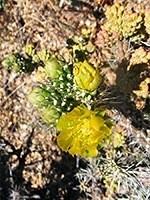Seashore Cactus
(Opuntia curvispina)

Description
Opuntia martiniana is a plant species in the genus Opuntia (Opuntia) from the cactus family (Cactaceae). Opuntia martiniana grows shrubby with spread but slightly ascending branches and reaches heights of up to 60 centimeters. The blue-green obovate to circular shoot sections are 9 to 16 centimeters long and just as wide. The areoles, which are rather close together, bear yellow, ocher or brown glochids. The one to eight spines are present on most or all areoles. They are mostly spreading, light yellow with a dull reddish brown base. The thorns reach a length of 2.5 to 4.5 centimeters. The yellow flowers sometimes have a reddish center. They are reach diameters of 5 to 8 centimeters. The reddish to reddish purple fleshy fruits have a diameter of 2.5 to 4 centimeters. Opuntia martiniana is distributed in the United States in northwest Arizona. The first description as Opuntia macrocentra var. martiniana by Lyman David Benson was published in 1950. Bruce Dale Parfitt elevated the variety to a distinct species in 1980. A nomenclatural synonym is Opuntia littoralis var. martiniana (LDBenson) LDBenson (1965). Opuntia, commonly called prickly pear or pear cactus, is a genus of flowering plants in the cactus family Cactaceae. Prickly pears are also known as tuna (fruit), sabra, nopal (paddle, plural nopales) from the Nahuatl word nōpalli for the pads, or nostle, from the Nahuatl word nōchtli for the fruit; or paddle cactus. The genus is named for the Ancient Greek city of Opus, where, according to Theophrastus, an edible plant grew and could be propagated by rooting its leaves. The most common culinary species is the Indian fig opuntia (O. ficus-indica). O. ficus-indica is a large, trunk-forming, segmented cactus that may grow to 5–7 m (16–23 ft) with a crown of over 3 m (10 ft) in diameter and a trunk diameter of 1 m (1 yd). Cladodes (large pads) are green to blue-green, bearing few spines up to 2.5 cm (1 in) or may be spineless. Prickly pears typically grow with flat, rounded cladodes (also called platyclades) containing large, smooth, fixed spines and small, hairlike prickles called glochids that readily adhere to skin or hair, then detach from the plant. The flowers are typically large, axillary, solitary, bisexual, and epiperigynous, with a perianth consisting of distinct, spirally arranged tepals and a hypanthium.
Taxonomic tree:







